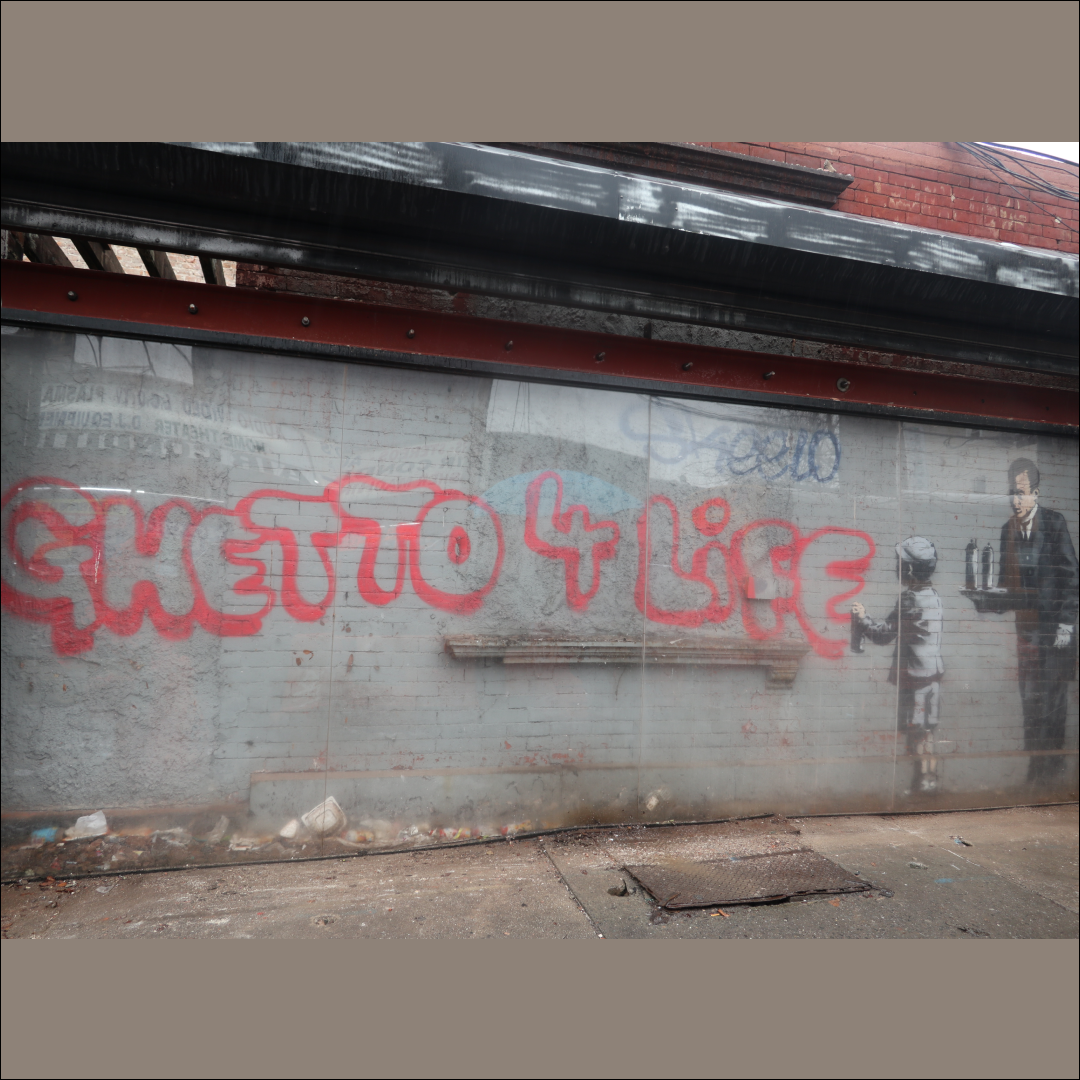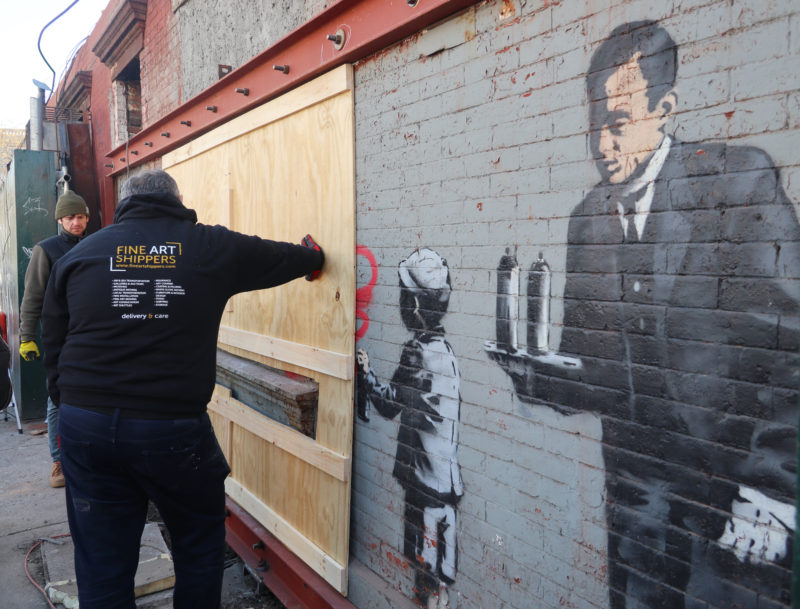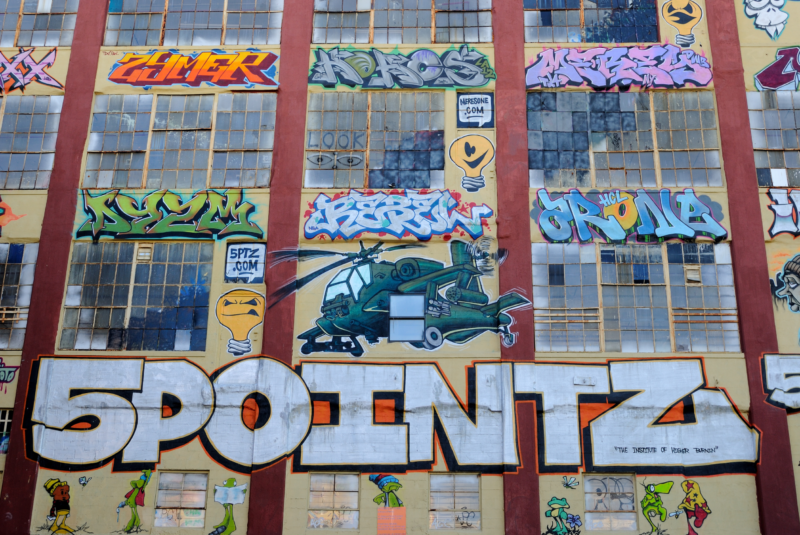
Street art has become an integral part of modern cities. From the graffiti-laden alleys of New York City to the mural-covered walls of Berlin, it is an important testament to the evolving narratives and dialogues that shape urban landscapes. In contrast to traditional art forms confined to the hallowed halls of galleries and museums, it is accessible and unmediated by the art world’s gatekeepers.
However, the very essence of street art—its public and accessible nature—makes it vulnerable. Urban development leads to the demolition of buildings adorned with murals, while legal ambiguities can result in significant works being painted over. Vandalism also poses a constant threat, with artworks being defaced or completely obliterated.
Street Art Needs Preservation
Fine Art Shippers firmly believes in the critical importance of preserving street art. We have executed several significant projects aimed at safeguarding such works and take pride in our involvement in relocating two Banksy artworks—those threatened by urban development—to safer locations.
After recently moving Banksy’s “Ghetto 4 Life” graffiti, we would like to share its story, alongside discussing other street artworks that have unfortunately been lost to development, negligence, and various other factors.
Ghetto 4 Life
Throughout October 2013, during Banksy‘s residency in New York, “Better Out Than In,” the British artist created a series of works around the city. Most of these pieces were quickly painted over by other graffiti artists, including a Chelsea piece of a dog peeing on a fire hydrant. Some, like the artwork featuring two boys under the “Graffiti is a Crime” sign at 18 Allen St., were removed by property owners or city officials.
“Ghetto 4 Life,” painted on a wall at 651 Elton Avenue in the South Bronx on October 22, 2013, has been fortunate to survive to the present day.
The graffiti shows a young boy spray-painting the words “Ghetto 4 Life.” What stands out is the boy’s outfit, which doesn’t match the image of a young boy from a poor urban area, especially with a butler serving drinks next to him.
Although the work initially sparked controversy within the community, it quickly turned into a tourist attraction, drawing crowds of visitors each year and earning the affection of locals. However, the recent decision to demolish the building threatened this piece with the same fate as other pieces from Banksy’s New York series. Fortunately, “Ghetto 4 Life” avoided being ruined or damaged. In February 2024, with the assistance and direct supervision of Fine Art Shippers, the artwork was successfully relocated to its new home in Connecticut, where it will preserved and taken care of.
“EU Mural” in Dover
In May 2017, Banksy painted a mural on a vacant arcade building in Dover, United Kingdom, capturing a moment almost a year after the UK’s 2016 referendum to leave the European Union. The work depicted a figure on a ladder chiseling away one of the 12 yellow stars from the circle on the EU flag. Valued at around $1.3 million, this piece quickly became a tourist attraction in the coastal town.
However, in August 2019, the mural was unexpectedly whitewashed, leaving the reasons behind this act largely unknown and sparking outrage and disappointment among locals and tourists. In November 2023, as part of Dover’s town redevelopment project, the building that featured Banksy’s mural was demolished.
Parachuting Rat
In the early 2000s, Banksy visited Melbourne, Australia, where he left several stencils of the “Parachuting Rat,” a recurring motif in his work. In 2010, one of these was painted over during a city cleanup, while another was vandalized. Eventually, in 2012, the third remaining piece was accidentally destroyed by a builder who drilled through it while installing a bathroom pipe.
***
These are just a few of the numerous pieces by Banksy that have been destroyed in various locations. Of course, countless works by other internationally recognized and lesser-known street artists have also been continuously destroyed.
Space Invader
Space Invader is a French street artist known for his distinctive mosaic installations inspired by the pixelated graphics of the 1978 arcade game Space Invaders, which he places in cities around the world. A few years after the street artist’s notable Invasion of Rome in 2010, during which he created his art in various parts of the city, some of his works mysteriously vanished from areas including the Esquilino district, the Termini station area, and Garbatella. A similar incident occurred in Paris in 2017. Witnesses reported seeing individuals attempting to remove his tiles from walls, who, when confronted, claimed they were working for the City of Paris. The city denied any involvement and filed a complaint for “usurpation of public functions.” Apparently, the vandals stole the valuable works with the intention of selling them.
5Pointz
5Pointz, an iconic warehouse in Queens, New York, dubbed a “graffiti mecca,” was the canvas for over 1,500 pieces of vibrant street art, attracting artists and admirers from around the world. This living collage of graffiti art, which covered the building’s facade with intricate murals and tags, symbolized the energy and creativity of the city’s urban art scene. However, in November 2013, the art community was left in shock when the building’s owner, seeking to redevelop the site into residential apartments, whitewashed the walls overnight, erasing years of artwork. The demolition of 5Pointz in 2014 marked the loss of a cultural landmark and a significant piece of New York City’s artistic heritage.
Jean-Michel Basquiat and Keith Haring
Before becoming famous in the art world, Jean-Michel Basquiat painted graffiti on Lower Manhattan buildings in the late 1970s under the name “SAMO.” Unfortunately, many of these early pieces were lost when the buildings were cleaned up or renovated. In a similar vein, Keith Haring’s vibrant murals were a common sight in public places, including the Berlin Wall. However, as the Wall came down, many of Haring’s artworks were either destroyed or went missing. Some of his murals in various other locations have also been painted over or damaged by weather over time.
The list of lost street art could go on. At Fine Art Shippers, we are dedicated to preserving all forms of art. We take particular joy in sharing our expertise and offering our services for the relocation of street art pieces. Cities are constantly evolving, and although urban landscapes change, preserving their spirit and history is possible—through the crucial artifacts and art pieces that bear witness to that history.


